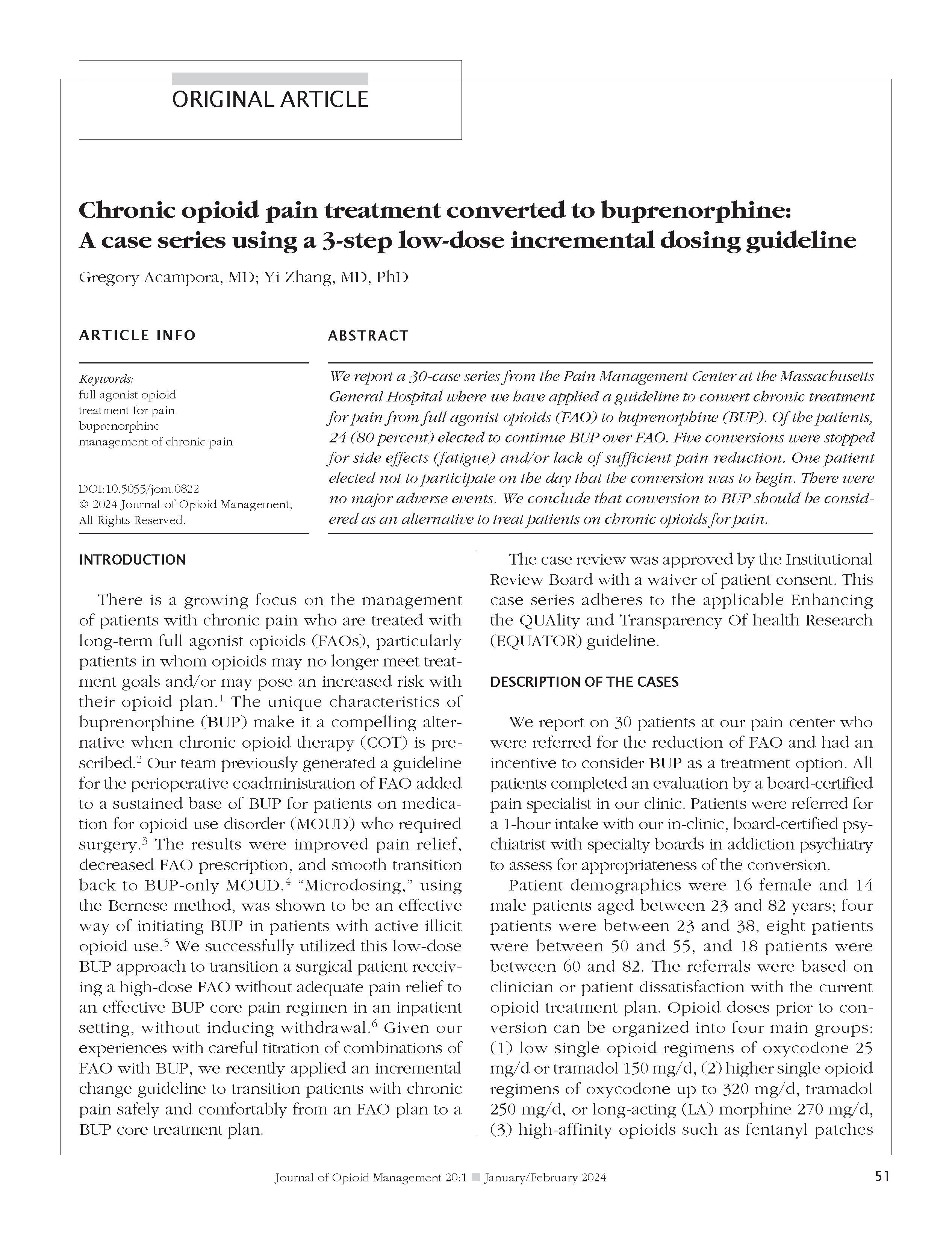Chronic opioid pain treatment converted to buprenorphine: A case series using a 3-step low-dose incremental dosing guideline
DOI:
https://doi.org/10.5055/jom.0822Keywords:
full agonist opioid, treatment for pain, buprenorphine, management of chronic painAbstract
We report a 30-case series from the Pain Management Center at the Massachusetts General Hospital where we have applied a guideline to convert chronic treatment for pain from full agonist opioids (FAO) to buprenorphine (BUP). Of the patients, 24 (80 percent) elected to continue BUP over FAO. Five conversions were stopped for side effects (fatigue) and/or lack of sufficient pain reduction. One patient elected not to participate on the day that the conversion was to begin. There were no major adverse events. We conclude that conversion to BUP should be considered as an alternative to treat patients on chronic opioids for pain.
References
CMS Government: HHS guide for clinicians on the appropriate dosage reduction or discontinuation of long-term opioid analgesics. Available at cms.gov. Accessed October 1, 2023.
Dalal S, Chitneni A, Berger AA, et al.: Buprenorphine for chronic pain: A safer alternative to traditional opioids. Health Psychol Res. 2021; 9(1): 27241. DOI: 10.52965/001c.27241. DOI: https://doi.org/10.52965/001c.27241
Acampora GA, Nisavic M, Zhang Y: Perioperative buprenorphine continuous maintenance and administration simultaneous with full opioid agonist: Patient priority at the interface between medical disciplines. J Clin Psychiatry. 2020; 81(1). DOI: 10.4088/JCP.19com12810. DOI: https://doi.org/10.4088/JCP.19com12810
Quaye A, Potter K, Roth S, et al.: Perioperative continuation of buprenorphine at low-moderate doses was associated with lower postoperative pain scores and decreased outpatient opioid dispensing compared with buprenorphine discontinuation. Pain Med. 2020; 21(9): 1955-1960. DOI: 10.1093/pm/pnaa020. DOI: https://doi.org/10.1093/pm/pnaa020
Hämmig R, Kemter A, Strasser J, et al.: Use of microdoses for induction of buprenorphine treatment with overlapping full opioid agonist use: The Bernese method. Subst Abuse Rehabil. 2016; 7: 99-105. DOI: 10.2147/SAR.S109919. DOI: https://doi.org/10.2147/SAR.S109919
Tara A, Acampora G, Wang J, et al.: Facilitating discontinuation of intravenous opioids by – concurrent use of sublingual buprenorphine with rapid microdosing – induction: A pain management case study. J Opioid Manag. 2021; 17(7): 153-158. DOI: 10.5055/jom.2021.0652. DOI: https://doi.org/10.5055/jom.2021.0652
Berna C, Kulich RJ, Rathmell JP: Tapering long-term opioid therapy in chronic noncancer pain: Evidence and recommendations for everyday practice. Mayo Clin Proc. 2015; 90(6): 828-842. DOI: 10.1016/j.mayocp.2015.04.003. DOI: https://doi.org/10.1016/j.mayocp.2015.04.003
Sandbrink F, Murphy JL, Johansson M, et al.: The use of opioids in the management of chronic pain: Synopsis of the 2022 updated US Department of veterans affairs and US Department of defense clinical practice guideline. Ann Intern Med. 2023; 176(3): 388-397. DOI: 10.7326/M22-2917. DOI: https://doi.org/10.7326/P22-0030
Kumar R, Viswanath O, Saadabadi A: Buprenorphine. In StatPearls. Treasure Island, FL: StatPearls Publishing, 2023.
SAMHSA: Waiver Elimination (MAT Act). Available at https://www.samhsa.gov/medications-substance-use-disorders/waiverelimination-mat-act. Accessed October 1, 2023.
Gudin J, Fudin J: A narrative pharmacological review of buprenorphine: A unique opioid for the treatment of chronic pain. Pain Ther. 2020; 9(1): 41-54. DOI: 10.1007/s40122-019-00143-6. DOI: https://doi.org/10.1007/s40122-019-00143-6
Gurevich VV, Gurevich EV: GPCR signaling regulation: The role of GRKs and arrestins. Front Pharmacol. 2019; 10: 125. DOI: 10.3389/fphar.2019.00125. DOI: https://doi.org/10.3389/fphar.2019.00125
Peterson YK, Luttrell LM: The diverse roles of arrestin scaffolds in G protein-coupled receptor signaling. Pharmacol Rev. 2017; 69(3): 256-297. DOI: 10.1124/pr.116.013367. DOI: https://doi.org/10.1124/pr.116.013367
Williams JT, Ingram SL, Henderson G, et al.: Regulation of μ-opioid receptors: Desensitization, phosphorylation, internalization, and tolerance. Pharmacol Rev. 2013; 65(1): 223-254. DOI: 10.1124/pr.112.005942. DOI: https://doi.org/10.1124/pr.112.005942
Greenwald MK, Herring AA, Perrone J, et al.: A neuropharmacological model to explain buprenorphine induction challenges. Ann Emerg Med. 2022; 80(6): 509-524. DOI: 10.1016/j.annemergmed.2022.05.032. DOI: https://doi.org/10.1016/j.annemergmed.2022.05.032

Published
How to Cite
Issue
Section
License
Copyright 2005-2025, Weston Medical Publishing, LLC and Journal of Opioid Management. All Rights Reserved.










